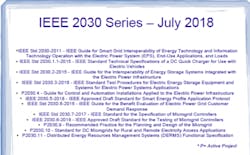IEEE Approves Second of Two Industry Standards for Microgrid Controllers
The Institute for Electrical and Electronics Engineers recently approved the second of two companion standards for advanced microgrid controllers. IEEE 2030.8 complements the previously approved IEEE 2030.7 by setting out an industry standard that specifies exactly what’s needed to test microgrid controllers.
*Provided by IEEE
More specifically, the suite of IEEE 2030.7 and IEEE 2030.8 standards is meant to foster and promote interoperability among the wide range of systems components and the external grid that makes for a state-of-the-art microgrid capable of operating in grid-connected and island modes. The focus is on describing the core functions of microgrid controllers in terms of testing and quantifying and verifying performance, according to Ward Bower, chair of the IEEE 2030.8 Standards Development Working Group.
Microgrid controllers and systems technology are advancing at a rapid pace, but a lack of technical definitions and standards has created uncertainty. The military, government agencies, grid operators, regulators and other stakeholders do not always know how define key functions in request for proposals (RFPs). That led to the creation of the IEEE 2030.7 and 2030.8 standards development working groups and the resulting technical standards, Bower said.
Companion standards for microgrid controllers
Approved in December 2017, IEEE 2030.7 – the Standard for the Specification of Microgrid Controllers – establishes an industry standard that lays out the technical and functional requirements of advanced microgrid controllers.
Taken together, the companion standards pave the way towards development of a comprehensive set of technical standards for microgrid controllers, according to Bower.
The controller enables the interface between the microgrid and the distribution utility during normal blue sky conditions and enables islanded operations during black sky conditions.
“These two operating modes offer optimization for energy management while connected to the grid and islanded energy supply for critical loads when the microgrid is disconnected from the grid,” he said.
The need for technical, industry standards for specifying, testing and comparing the performance of microgrid controllers became increasingly apparent as microgrids began emerging as a credible means to enhance grid reliability and resiliency, Bower said.
“Microgrid research and development, applications and installations were being delayed or stymied because stakeholders were having difficulty defining what a microgrid should do or how to specify the operations,” he said.
Development of two companion standards is a common approach for IEEE, according to Géza Joós, a McGill University professor of electrical and computer engineering and the author of both standards.
“If you were to create an RFP, for example, you would refer first to 2030.7 to specify the components and functions of a microgrid controller, then add a section on test specifications and procedure by referring to 2030.8,” he said.
IEEE 2030.8 should be officially released in 8-10 weeks. “The next step is the IEEE editorial processes, which is now underway,” Bower said. No changes are expected regarding the technical aspects of the standard. Rather this final step in the process ensures that the documentation complies with IEEE standards for structure and composition.
Additional standards also would benefit the industry. For example, a step-by-step testing procedure for microgrid controllers will be needed once standard-compliant controllers become commercially available. That initiative would take about three years to complete.
Track news about microgrid controllers. Subscribe to the free Microgrid Knowledge newsletter.
